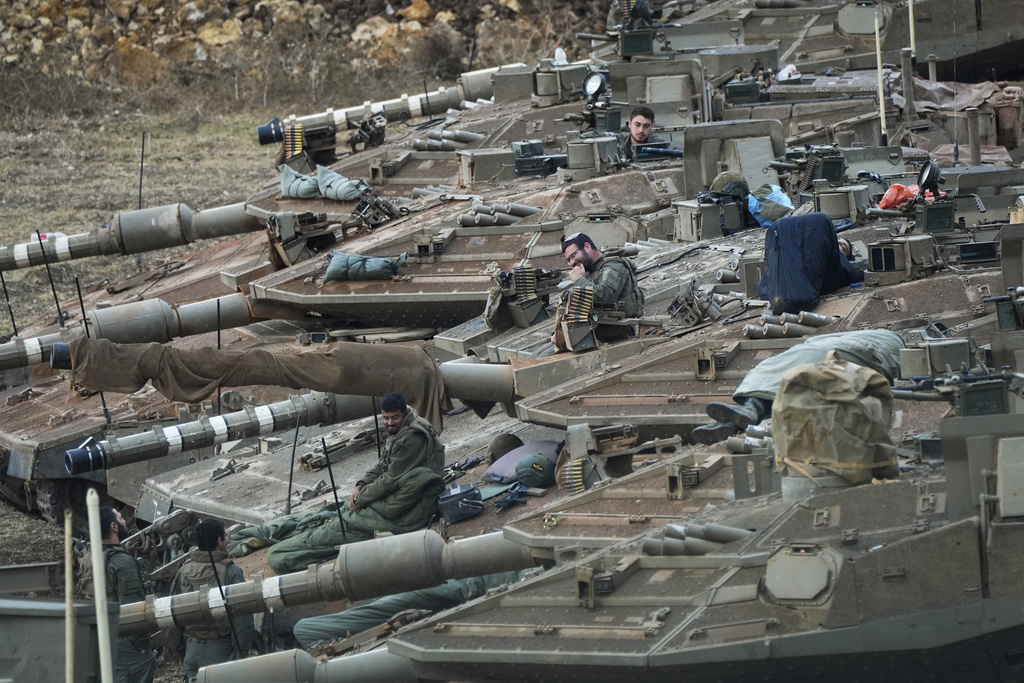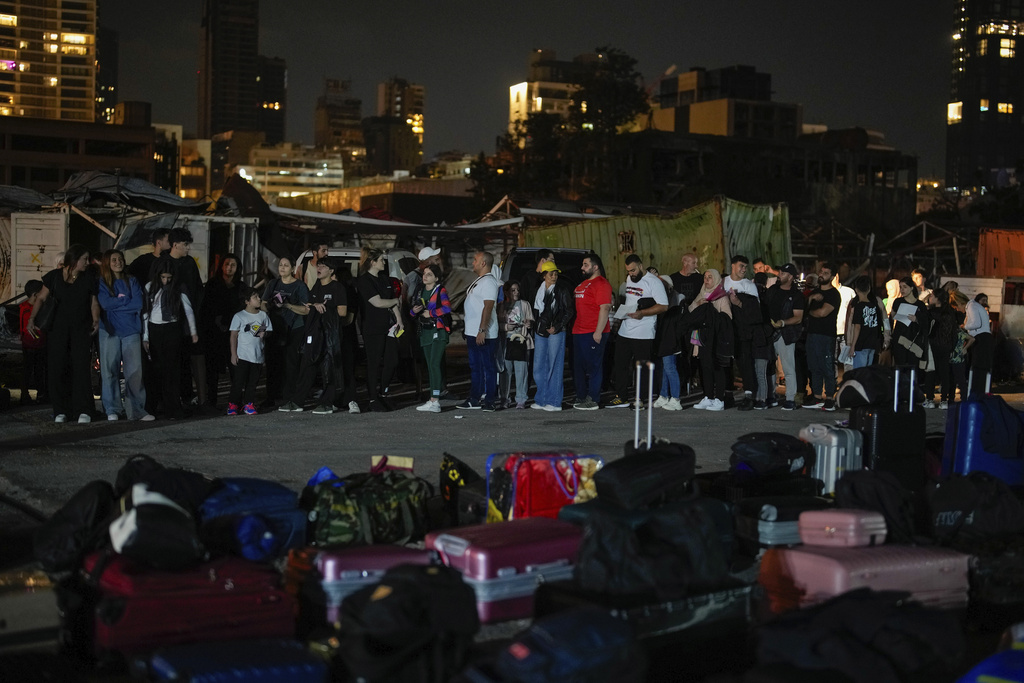Hezbollah Attacks Intensify as Israel Expands Lebanon Operations \ Newslooks \ Washington DC \ Mary Sidiqi \ Evening Edition \ Israel’s ground invasion in Lebanon has entered its second week as Hezbollah launches hundreds of rockets deep into Israeli territory. Over 1,400 people in Lebanon have died, mostly from airstrikes, and more than a million have been displaced since the conflict began in September. Israeli forces are targeting Hezbollah’s infrastructure near the border, while Hezbollah continues its ambushes and rocket barrages, with no diplomatic solution in sight.

Israel’s Ground Invasion in Lebanon: Quick Looks
- Conflict Duration: The ground invasion has stretched into its second week.
- Casualties: Over 1,400 Lebanese deaths and 17 Israeli deaths, including soldiers and civilians.
- Hezbollah Strategy: Hezbollah ambushes Israeli troops, fires rockets deep into Israeli territory.
- Israel’s Goal: Target Hezbollah infrastructure and secure the border region.
- Potential for Diplomacy: Hezbollah has signaled openness to a ceasefire, but peace talks remain elusive.
Deep Look:
Israel’s ground invasion in Lebanon has now entered its second week, with no immediate end in sight as the conflict between Israel and Hezbollah escalates. Since Hezbollah began firing rockets into Israeli territory on October 8, 2023, following a Hamas attack on southern Israel, daily exchanges of fire between Israeli forces and Hezbollah militants have pushed the region closer to full-scale war. The Israeli military’s efforts are concentrated on dismantling Hezbollah’s military infrastructure along the border, while Hezbollah continues to respond with increasing intensity.
The toll of the conflict has been devastating for Lebanon. Since the fighting intensified in mid-September, more than 1,400 people have been killed, primarily due to Israeli airstrikes, and over a million Lebanese civilians have been displaced. On the Israeli side, 15 soldiers and two civilians have been killed since the ground invasion began. Additionally, more than 60,000 Israelis living along the border have been displaced for more than a year due to ongoing hostilities.
Hezbollah, a Lebanon-based militant group backed by Iran, began firing rockets into Israel in early October, just one day after Hamas, the Palestinian militant group, launched an assault on southern Israel. This led to the outbreak of war in Gaza, which subsequently drew in Hezbollah. While Israel and Hezbollah have traded fire sporadically over the years, the escalation into a near-continuous exchange since October has marked a turning point. The two sides have come perilously close to all-out war on several occasions, though tensions were diffused each time—until now.
What is the Aim of Israel’s Ground Invasion?
Israel’s military launched its ground invasion of southern Lebanon on October 1, 2023, under the guise of “limited, localized, and targeted ground raids.” According to the Israeli military, the purpose of these operations is to dismantle Hezbollah’s infrastructure near the border and allow displaced Israeli residents to return to their homes. Israeli officials have confirmed that they have carried out dozens of secretive cross-border operations to disrupt Hezbollah activities over the past year.
Currently, thousands of Israeli troops are operating along the approximately 100-kilometer (62-mile) border with Lebanon. Their primary mission is to clear the border area of Hezbollah’s rocket launch sites, as well as other infrastructure that could potentially facilitate an invasion of Israel akin to the deadly Hamas attack on October 7. So far, Israeli forces have not ventured far into Lebanese territory, with the military’s incursions limited to distances of a few hundred meters up to 3 kilometers (about 2 miles) into southern Lebanon.
One military official, speaking anonymously, noted that the goal is not to completely eliminate Hezbollah but rather to significantly weaken their military capabilities near the border. Videos shared by the Israeli military purportedly show underground tunnels used by Hezbollah to store weapons and stage attacks. Some of these tunnels even cross into Israeli territory, according to military reports.
Despite these efforts, the long-term success of the operation remains unclear. Israel’s military acknowledges that the threat of longer-range rockets, such as those capable of hitting major cities like Haifa, will not be completely removed by this campaign.
Hezbollah’s Strategy
Hezbollah’s response has been swift and intense. Although the group has acknowledged Israel’s superior air force and intelligence, Hezbollah has focused on using its elite Radwan Forces to ambush Israeli troops as they enter Lebanese territory. Hezbollah fighters are detonating explosive devices and launching rockets at incoming Israeli soldiers. The militants have also continued to fire heavy barrages of rockets into Israeli border towns, with some rockets reaching deeper into Israel, including the city of Haifa.
Unlike Hamas, Hezbollah’s forces are better trained and equipped, thanks to their experience in the conflicts in Syria and Iraq. Lebanon’s rugged terrain also gives Hezbollah an advantage in defending against Israeli forces, which are primarily conducting reconnaissance missions ahead of what could be a larger ground operation. Former Lebanese Army General Hassan Jouni stated that Israel’s military may have suffered losses already in these smaller operations due to Hezbollah’s prepared defenses, including a network of tunnels and weapons caches.
Jouni added that Hezbollah’s strategy is built around luring Israeli forces deeper into Lebanese territory, where they can be more easily ambushed. “The land always works in the favor of those who own it,” he said, highlighting how Hezbollah’s familiarity with Lebanon’s difficult terrain gives them a home-field advantage.
How Does This Compare to the 2006 War?
The current conflict between Israel and Hezbollah bears similarities to their last major confrontation in 2006, which lasted 34 days and ended with the implementation of United Nations Resolution 1701. That resolution required Hezbollah to withdraw from the southern border region and for the Lebanese army and UN peacekeepers to take control. Israeli officials say Hezbollah has not fully adhered to the resolution, while Hezbollah claims that Israel has failed to honor its part of the treaty.
In the 2006 conflict, Israeli forces launched a ground invasion after 10 days of intense airstrikes, pushing their troops as far as the Litani River, approximately 30 kilometers (18.5 miles) from the Israeli border. However, Israeli troops faced heavy losses during this incursion, and they withdrew shortly after a cease-fire was brokered.
Yoel Guzansky, a senior researcher at the Institute for National Security Studies in Tel Aviv, remarked that Israel’s air campaign in southern Lebanon has become more precise since 2006. Israeli intelligence has improved, allowing them to target key Hezbollah leaders. For instance, Hezbollah leader Hassan Nasrallah was killed in September during an Israeli airstrike that dropped over 80 bombs on a Beirut apartment complex built over an underground Hezbollah compound.
Is a Diplomatic Solution Possible?
While military action escalates, there have been hints of a possible diplomatic resolution. Hezbollah’s acting leader has signaled that the group may be open to a cease-fire under certain conditions. Guzansky suggests that Israeli forces will likely remain in southern Lebanon until a stronger, internationally enforced diplomatic agreement is reached, potentially going beyond the scope of the current UN peacekeeping mission.
However, former Israeli Prime Minister Ehud Olmert, who was in power during the 2006 conflict, has urged for immediate diplomacy rather than continued military action. In an interview, Olmert argued that prolonging the war could result in heavy casualties on both sides without achieving a different outcome. “Why not try and make a deal now rather than fight for half a year?” he said, noting that a diplomatic agreement could have been reached before the bloodshed.
For now, the fighting continues with no clear timeline for peace. Both Israel and Hezbollah remain entrenched in their positions, and the risk of further escalation looms large as the region edges closer to a full-scale war.
Hezbollah Attacks







